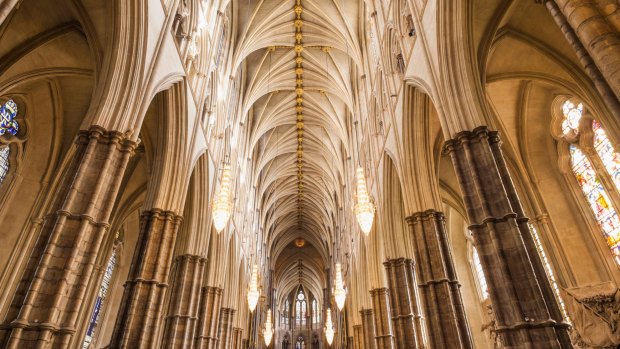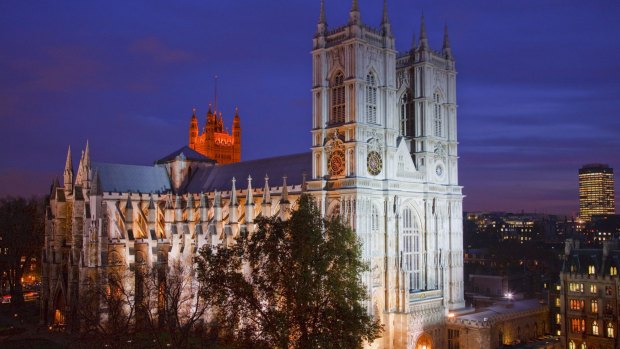This was published 6 years ago
Westminster Abbey: Where to mingle with London's most famous

Grand design: The nave at Westminster Abbey.Credit: Alamy
Westminster Abbey is quite the place to walk among the dead famous. If you had the ability to conjure up the spirits, you'd soon be conversing with Newton and Dickens and swapping "off with her head!" jokes with Tudor queens. You could ask George II about his mistresses and silly wigs – he was the last of 17 monarchs (in 1760) to be tucked away under a marble slab in the abbey.
For anyone who has read Philippa Gregory or Hilary Mantel, or has any interest in British history and culture, a walk around Westminster Abbey provides a who's who of extraordinary encounters. Fans of the Tudors will be titillated and aghast to find Elizabeth I – whose effigy features an enormous ruff and impressive nose – lies literally on top of her rival sister Mary I, with whom she had a tortured, bitter relationship. Her rival cousin Mary Queen of Scots is just across the aisle, looking pouty and pious in marble.
The first interred monarch is Edward the Confessor, who founded Westminster Abbey in 1065 and was for centuries venerated here as a saint. The current abbey, however, owes much to French-influenced, 13th-century remodelling. As dead royals were shuffled from one spot to the other (closeness to the altar being a sign of temporary favour) so the architecture too received occasional makeovers. The twin towers atop the west entrance are 18th-century additions, and most of the stained glass is relatively modern.

Westminster Abbey lit up at night.
In short, Westminster Abbey has grown like some improbable reef, with centuries of encrusted gargoyles and mermaids, busts of empire-makers, Italianate tombs and memorial plaques. It's actually a whole cluster of buildings including cloisters, a splendid Chapter House and some overlooked 900-year-old gardens. The latest addition, the Queen's Diamond Jubilee Galleries, opens this June in the hitherto unseen triforium (the gallery above the nave) and charts the abbey's architectural, ecclesiastical and royal history.
From an architectural viewpoint, the highlight is the Henry VII Chapel, which lurks behind brass railings at the nave's eastern end. It's one of Europe's masterpieces of late medieval design, whose ornate, elegant vaulted ceiling is hung with banners like a scene from a Harry Potter movie. Stained glass commemorating the 1940 Battle of Britain is oddly anachronistic but striking.
All but two English (and later British) monarchs have been crowned in the abbey, most on the battered, graffiti-scratched Coronation Chair. The tombs are far more interesting, and not necessarily the royal ones, many of which are quite plain. More than 3300 notable dead people are jammed into the abbey's floors and walls in a fascinating collection of tombs, statues and sculpture work that traces centuries of changing design fashions.
Poet's Corner alone will keep you busy. Geoffrey Chaucer was the first literary great to be buried here in 1400, though only because he lived in the parish. It wasn't until the 18th century that the vogue for assembling Britain's literary dead developed. Dryden, Sheridan, Browning, Hardy, Kipling, Tennyson and Wordsworth are among them; dramatist Ben Jonson is the only person in the abbey buried upright. Many others have memorial plaques. A marble Shakespeare leans against a stack of books.
Other British greats such as scientists, explorers and prime ministers are also remembered. The Tomb of the Unknown Warrior lies in front of the west entrance. Isaac Newton's elaborate memorial attracts fanatics of The Da Vinci Code. Manhole covers inadvertently commemorate late-19th-century toilet manufacturer Thomas Crapper, who held the royal warrant for plumbing. If you could conjure up his spirit, that would be quite the conversation.
Cathay Pacific flies from Sydney and Melbourne (9hr) to Hong Kong with onward daily connections to London (13.5 hr). Phone 131 747, see cathaypacific.com.au
TOUR
Westminster Abbey is open Monday to Saturday, but check for special events. Adult tickets £20 ($35) if purchased online. Informative verger-led, 90-minute tours are £5 ($9). See westminster-abbey.org
STAY
The recently revamped Mandarin Oriental Hyde Park is a grand landmark building in a very convenient city-centre location. It has excellent service and a Heston Blumenthal restaurant. See mandarinoriental.com
Brian Johnston travelled as a guest of Visit Britain, Viking Cruises and Mandarin Oriental Hyde Park.
Sign up for the Traveller Deals newsletter
Get exclusive travel deals delivered straight to your inbox. Sign up now.